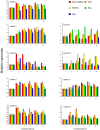Genome-Wide Analysis and Expression Profiling of the Phospholipase C Gene Family in Soybean (Glycine max)
- PMID: 26421918
- PMCID: PMC4589352
- DOI: 10.1371/journal.pone.0138467
Genome-Wide Analysis and Expression Profiling of the Phospholipase C Gene Family in Soybean (Glycine max)
Abstract
Phosphatidylinositol-specific phospholipase C (PI-PLC) hydrolyses phosphatidylinositol-4,5-bisphosphate to produce diacylglycerol and inositol 1,4,5-trisphosphate. It plays an important role in plant development and abiotic stress responses. However, systematic analysis and expression profiling of the phospholipase C (PLC) gene family in soybean have not been reported. In this study, 12 putative PLC genes were identified in the soybean genome. Soybean PLCs were found on chromosomes 2, 11, 14 and 18 and encoded 58.8-70.06 kD proteins. Expression pattern analysis by RT-PCR demonstrated that expression of the GmPLCs was induced by PEG, NaCl and saline-alkali treatments in roots and leaves. GmPLC transcripts accumulated specifically in roots after ABA treatment. Furthermore, GmPLC transcripts were analyzed in various tissues. The results showed that GmPLC7 was highly expressed in most tissues, whereas GmPLC12 was expressed in early pods specifically. In addition, subcellular localization analysis was carried out and confirmed that GmPLC10 was localized in the plasma membrane in Nicotiana benthamiana. Our genomic analysis of the soybean PLC family provides an insight into the regulation of abiotic stress responses and development. It also provides a solid foundation for the functional characterization of the soybean PLC gene family.
Conflict of interest statement
Figures







Similar articles
-
Genomic-Wide Analysis of the PLC Family and Detection of GmPI-PLC7 Responses to Drought and Salt Stresses in Soybean.Front Plant Sci. 2021 Mar 3;12:631470. doi: 10.3389/fpls.2021.631470. eCollection 2021. Front Plant Sci. 2021. PMID: 33763092 Free PMC article.
-
Comprehensive genomic analysis and expression profiling of phospholipase C gene family during abiotic stresses and development in rice.PLoS One. 2013 Apr 30;8(4):e62494. doi: 10.1371/journal.pone.0062494. Print 2013. PLoS One. 2013. PMID: 23638098 Free PMC article.
-
Genomic and expression analysis indicate the involvement of phospholipase C family in abiotic stress signaling in chickpea (Cicer arietinum).Gene. 2020 Aug 30;753:144797. doi: 10.1016/j.gene.2020.144797. Epub 2020 May 23. Gene. 2020. PMID: 32454180
-
Plant phosphoinositide-dependent phospholipases C: variations around a canonical theme.Biochimie. 2014 Jan;96:144-57. doi: 10.1016/j.biochi.2013.07.004. Epub 2013 Jul 12. Biochimie. 2014. PMID: 23856562 Review.
-
Plant phospholipase C family: Regulation and functional role in lipid signaling.Cell Calcium. 2015 Aug;58(2):139-46. doi: 10.1016/j.ceca.2015.04.003. Epub 2015 Apr 17. Cell Calcium. 2015. PMID: 25933832 Review.
Cited by
-
Genomic-Wide Analysis of the PLC Family and Detection of GmPI-PLC7 Responses to Drought and Salt Stresses in Soybean.Front Plant Sci. 2021 Mar 3;12:631470. doi: 10.3389/fpls.2021.631470. eCollection 2021. Front Plant Sci. 2021. PMID: 33763092 Free PMC article.
-
Comprehensive Genomic Analysis and Expression Profiling of Diacylglycerol Kinase (DGK) Gene Family in Soybean (Glycine max) under Abiotic Stresses.Int J Mol Sci. 2019 Mar 18;20(6):1361. doi: 10.3390/ijms20061361. Int J Mol Sci. 2019. PMID: 30889878 Free PMC article.
-
Emerging role of phospholipase C mediated lipid signaling in abiotic stress tolerance and development in plants.Plant Cell Rep. 2021 Nov;40(11):2123-2133. doi: 10.1007/s00299-021-02713-5. Epub 2021 May 18. Plant Cell Rep. 2021. PMID: 34003316 Review.
-
32Pi Labeled Transgenic Wheat Shows the Accumulation of Phosphatidylinositol 4,5-bisphosphate and Phosphatidic Acid Under Heat and Osmotic Stress.Front Plant Sci. 2022 Jun 14;13:881188. doi: 10.3389/fpls.2022.881188. eCollection 2022. Front Plant Sci. 2022. PMID: 35774812 Free PMC article.
-
A review of biotechnological approaches towards crop improvement in African yam bean (Sphenostylis stenocarpa Hochst. Ex A. Rich.).Heliyon. 2021 Nov 25;7(11):e08481. doi: 10.1016/j.heliyon.2021.e08481. eCollection 2021 Nov. Heliyon. 2021. PMID: 34901510 Free PMC article. Review.
References
-
- Nakamura Y, Awai K, Masuda T Yoshioka Y, Takamiya K, Ohta H (2005) A novel phosphatidylcholine-hydrolyzing phospholipase C induced by phosphate starvation in Arabidopsis . J Biol Chem 280: 7469–7476. - PubMed
-
- Berridge MJ (1987) Inositol trisphosphate and diacylglycerol: two interacting second messengers. Annu Rev Biochem 56: 159–193. - PubMed
-
- Meldrum E, Parker PJ, Carozzi A (1991) The PtdIns-PLC superfamily and signal transduction. Biochim Biophys Acta 1092: 49–71. - PubMed
Publication types
MeSH terms
Substances
LinkOut - more resources
Full Text Sources
Other Literature Sources
Research Materials
Miscellaneous

